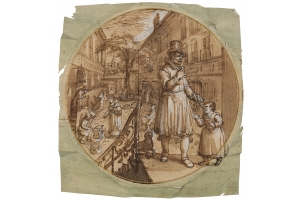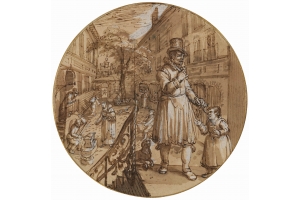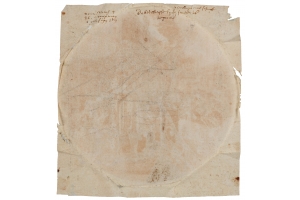


David Vinckboons was born on the 13th of August 1576 as son of the painter Philip Vinckeboons I (1545- c.1601) and Cornelia Querrez/Carree/Carré (died 1606). Due to the Spanish occupation the family first moved from Mechelen to Antwerp in 1586 and subsequently to the North, where they first settled in Middelburg (1586-1591) and later in Amsterdam (1591-1633), where father Philip was first registered as a citizen on 11 March 1591.[1]
Taught by his father Philip, especially in the first half of his career, David worked in the tradition of Pieter Brueghel the Elder (1526/30-1569) and Gilles van Coninxloo II (1544-1606/07) after which he developed as a genre painter, draughtsman and engraver.
David married in Leeuwarden in 1602 to Agneta van Loon (died 1668) and the couple had probably more than ten children of who at least seven reached adult age: Pieter (1605-1644), Philips II (c.1608-1678), Johannes(Jan) (c.1617-1670), Justus (c.1621-1698), David II (c.1623-1679), Maria (c.1626-1680) and Aernout Vingboons (1630-1702). David bought a large house in 1611 in St. Anthonisbreestraat 64, which became the base for the family business of him and his sons (who were cartographers and architects). David was teacher of Hendrick Avercamp (1585-1634), Joost Cornelisz. Droochsloot (1586-1666), his sons David II, Johannes and Pieter and possibly of Esaias van de Velde (1587-1630) as well.
The present tondo emblem drawing closely follows in the tradition of the cartouche drawings Vinckboons made for maps. This might have been as early as 1605 on a map published by Willem Blaeu (1571-1638), but securely on five bible maps engraved by Pieter Platevoet or Petrus Plancius (1552-1622) first published by the Amsterdam printer, publisher and bookseller Jan Evertsz. Cloppenborch (1571-1648) in 1604.[2] The three maps in which Vinckboons collaborated, show fifteen oval engravings illustrating bible stories. For the central print depicting Adam and Eva in the Garden of Eden, the preparatory drawing, indented for transfer is in the British Museum, London.[3] At least four more preparatory designs in mirror image can be securely given to Vinckboons, all preserved in Staatliche Museen, Kupferstichkabinett, Berlin. Several years later Vinckboons drew a large design of Plancius, instructing students in the science of navigation which is now in the collections of the Metropolitan Museum of Art, New York.[4] Vinckboons also collaborated with Claes Jansz. Visscher (1586/87-1652) and Pieter Serwouters (1586-1657) around 1607-08 which resulted in a series of prints.
Paulus de Kempenaer (Brussels c.1554-1618? The Hague) was a Protestant theologian, calligrapher, emblematist, heraldic painter and poet. He was born in Brussels in the 1550's and settled in Leyden c.1584/85. Born as the son of the apothecary Paulus de Kempenaer and Clara Bruyneels he was well-educated, mastered several languages and seemed to have knowledge on theology, chemistry and medicine also. Paulus apprenticed to the lawyer Jean de Leeuw in c.1572 and settled c.1578 at the staff of Nicasius de Silla in Antwerp. In 1583 he married Jacqueline Darbant. He was well known among a wide range of leading figures. Attracted to mysticism he fled Antwerp in 1584 when the Spanish troops entered the city and settled in Leyden.[5] In 1599 he was honored by Jan van de Velde (1568-1623) in his defence of calligraphy. De Kempenaer seems well known in well to do environments among the nobility and gentry. During his Leyden period, de Kempenaer was in close contact with some of the best known contemporary artists like Hendrik Hondius (1573-1650), Jacques de Gheyn II (1565-1629) and David Vinckboons (1576-c.1632). Drawings by Paulus are filled with controversial elements of folly, memento mori, warnings against vanity and lust, predestination, death, wisdom and oftenly filled with scribblings in the blank margins, which is also the case in the present drawing, though far less present compared to drawings in his very own hand.
This recently discovered tondo by David Vinckboons depicts a lively courtyard with salesmen on the far right, merchants carrying their goods in bags and baskets and a man leaning on a balustrade while watching a blacksmith and a beggar with her child on what appears to be a sunny Summer day. The elegantly dressed gentleman in the direct foreground on the right literally takes stage and is the center as well as repoussoir of the drawing. He seems to be enjoying a piece of fruit which he just peeled. The little girl on the far right begging for a piece of the fruit or it's peel, which he holds in his left hand together with the sheath of the knife.
The manuscript annotations by Paulus de Kempenaer on the upper right and left on verso reveal and affirm the authorship for David Vinckboons and correspondence on the drawing between Vinckboons and de Kempenaer. On the upper right corner on verso de Kempenaer wrote Vinckenboons schreef....de bedelares by de schmidt is te groot (Vinckenboons wrote...the beggar at the blacksmith is too large). This perfectly corresponds with the drawing, as the beggar holding her child is slightly out of proportion compared to the seated blacksmith.
On the upper left corner de Kempenaer wrote a more illustrious devotional annotation which seems to contain the words “O coopman, o gulsigen” and "iden" (lieden), which reflects on the contradiction between rich and poor and the importance of clemency or charity. This is depicted by the beggar who begs for alms at the blacksmith, where the blacksmith doesn't seem to pay attention to the beggar at all. The rich man on the direct foreground (who is the Coopman referred to in the annotations on the upper left on verso) with "capotain" hat is typically for the fashion around 1610. The painting by Willem Buytewech (1591/92-1624) at the Rijksmuseum shows similar fashion.[6] The Coopman only gives the peel of his fruit to the little girl who begs, which is a warning against merciless behavior. The dog in the background of the courtyard also seems to beg, which confirms the message of this emblem tondo drawing. The couple in the far background at the stall may also be beggars, although speculative. The annotation Swaef might refer to Johannes de Swaef (Swave 1594-1653) or Samuel de Swaef (Swaaf 1597-1636).
The present tondo with devotional emblem message therefore should be interpretated as a warning against a lack of clemency.
On the verso a sketch in black chalk, for the pentimenti in the composition of the top roof of the courtyard on the right. Vinckboons has repositioned this and charmingly covered his corrections with clouds heightened with white to close the composition.
The composition of the tondo recalls several drawings from the series of The Twelve Months by Hans Bol (1534-1593), preserved in the collections Museum Boijmans Van Beuningen. Especially the months of January, April and most of all May show similar spatial compositions, with numerous figures undertaking actions in a square centered plane with a central vanishing point.[7] The series of the Four Elements by Jacob Savery I (1565/67-1603) with a large central figure in the foreground depicting an allegory also show great similarities regarding subjects and compositions. Both artist fled from the Southern Netherlands, just like David Vinckboons to the Northern Netherlands in fear of the Spanish persecution.
Both David Vinckboons (1576-c.1632) and Paulus de Kempenaer (1544/64-1618) were reformed expatriate from the Southern Netherlands who moved to the Northern Netherlands. Pauls de Kempenaer closely collaborated with David Vinckboons in the year 1612-1613, after which the collaboration abruptly ended.[8] This most probably due to the hot-headed temperament of de Kempenaer, whose collaborations never seemed long lasting. The aforementioned date perfectly corresponds with the dating of both tondos recorded in the catalogue raisonné on David Vinckboons by Dr. Klaus Ertz, who dates both drawings c.1613 which now can be ranked with our drawing as part of a series of 46 emblem tondo drawings which we will discuss hereafter.[9][10] One of these was previously part of the collection Jacobus A. Klaver (1928-1997), now in a private-collection, the other appeared on the market in 1989, now in the collection of Musée du Louvre.[11][12]
All three drawings are of similar dimensions, on green/blue prepared paper and double gold ink borders for the tondo's with a diameter of c.120-122 mm each. Of the three tondo's, only the sheet with The Louvre appears to be (partly) indented for transfer, contrary to our sheet which isn't. This might indicate de Kempenaer commissioned the designs and they were intended to be published as prints, though the sheets were arrested in the middle of the workshop process and the prints were never published nor edited.
The present tondo by Vinckboons was commissioned directly from the artist by de Kempenaer for a series of 46 emblems and was kept in the family ever since. Thanks to the annotations in de Kempenaers hand on the verso, this drawing is the first concrete evidence and proof of the collaboration between Vinckboons and de Kempenaer for the series of emblems. A hypothesis first stated by Dr. Daan van Heesch in his essay on Paulus de Kempenaer and the political exploitation of Hieronymus Bosch in the Dutch Revolt. De Kempenaer dedicated two poems to Vinckboons in 1612 and refers to a series of emblems he commissioned from Vinckboons which he promised to send. In another letter Paulus de Kempenaer refers to a series of drawings he commissioned from Vinckboons on the Fall of Men, which were engraved by Henrick de Kempenaere.
The iconography of the three drawings known, range from religious (Adam and Eve and their children), Macabre Allegories and Allegory on Clemency, thus covering a vast scope of subjects, which makes it tentatively impossible to interpret a certain coherence for the emblem series, apart from devotional messages.
The drawing originates straight out of Vinckboon's workshop and has never been on the market.
A warm thanks to Dr. Daan van Heesch and Dr. Ruben Suykerbyk for their help with unraveling de Kempenaer's annotations on the verso.[13]
[1] Dr. Klaus Ertz, David Vinckboons 1572-1632. Monographie mit kritischem Katalog der Zeichnungen und Gemälde. Luca Verlag Linden, 2016.
[2] Sh.K. Bennett, 'Drawings by David Vinckboons as Models for Ornamenting Bible Maps',
Mercury (1989), no. 10, p. 15-25
[3] David Vinckboons, Garden of Eden; Adam and Eve beneath a tree by a river, surrounded by animals including a unicorn, lion and peacock.
Pen and brown ink, with grey wash and watercolour, with lines indented, 174 x 167 mm. Signed with monogram in lower left, in pen and ink: "DVB"
British Museum, London. inv. no. 1923,0113.19
[4] David Vinckboons, Petrus Plancius Instructing Students in the Science of Navigation.
Black chalk, pen and brown ink, grey wash, 252 x 277 mm.
Metropolitan Museum of Art, New York. inv. no. v2003.4
[5] Alastair Hamilton, Paulus de Kempenaer, non moindre Philosphe que tresbon Escrivain,
Quaerendo 10 (1980), p. 293-335
[6] Willem Buytewech, Elegant Couples Courting.
Oil on canvas, 56,3 x 70,5 cm. Rijksmuseum Amsterdam, inv. no. SK-A-3038.
[7] Hans Bol, The Twelve Months (1580).
Pen and brown ink, brown wash, diam. of 140 mm each.
Museum Boijmans Van Beuningen, Rotterdam, inv. no. MB 2005/T 2 e (PK)
[8] Dr. Daan van Heesch, Paulus de Kempenaer and the Political Exploitation of Hieronymus Bosch in the Dutch Revolt, Simiolus 41:1-2 (2019): pp. 5-38. (note 126), p.33
[9] Dr. Klaus Ertz, David Vinckboons 1572-1632. Monographie mit kritischem Katalog der Zeichnungen und Gemälde. Luca Verlag Linden, 2016. Z 108, Adam und Eva mit ihren Kindern, p.247
[10] Op Cit., Z 177, Allegorie des Todes, p.289
[11] David Vinckboons, Adam and Eve and their children.
Pen and brown ink, grey-blue and brown wash, heightened with white and gold, sheet 139 x 142 mm, image diameter 120 mm. Private-collection.
[12] David Vinckboons, Allégorie macabre.
Plume et encre brune, lavis d'indigo, rehauts de gouache blanche, traces de stylet. Double trait d'encadrement circulaire à l'or, 148 x147 mm.
Musée du Louvre, Paris, inv. no. RF 51936
[13] Correspondence by e-mail, 14 June 2024 and 9 November 2024.